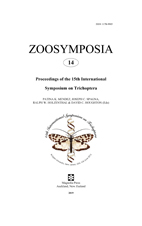Abstract
Barcoding datasets can serve as a resource for species associations and delineations, but single-gene trees estimated by distance methods do not provide strong estimates of phylogeny. Using DNA data from the Barcode of Life Database (BOLD), we calculate a phylogenetic tree for Oligophlebodes (Trichoptera: Thremmatidae), a small genus of caddisfly endemic to the Western United States. Here we estimate a preliminary phylogeny for Oligophlebodes using Bayesian likelihood, and compare it to trees produced by distance and standard likelihood methods. Using the barcode region of the cytochrome oxidase 1 (COI) gene, we analyzed 44 individuals representing five species (and 2 unknowns) and a sister-genus outgroup (Neophylax) from locations ranging from Southern New Mexico northwest into British Columbia. Partitioned Bayesian likelihood analysis under the F81 (1st codon positions) and HKY80 + I + Γ (for both the 2nd and 3rd codon positions) model gave the consensus topology (Neophylax toshi, (O. sierra, (O. ruthae inc. spc. 1 & 2, O. sigma, (spc. 3 & 4, (O. ardis, O. minutus)))). Species identifications were supported by monophyly of most species-level taxa. However, confirmation of species identifications of unknowns was complicated by incomplete taxon sampling for spc. 1 & 2. Placement of spc. 3 & 4 may serve as support for taxonomic review of O. minutus. Compared with an existing published phylogeny of Oligophlebodes BOLD sequences constructed under RAxML, the Bayesian hypothesis had higher resolution at the basal node of Oligophlebodes. Because of their support values, both likelihood trees are recommended over the BOLD TaxonID tree (an unrooted neighbor joining tree using the Kimura 2-parameter model). The novel topology produced in the Bayesian tree supports further explorations by likelihood-based methods, including partitioned analyses, of our preliminary Oligophlebodes dataset that can be used as additional lines of evidence to support morphological work.

